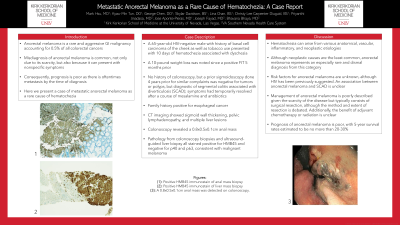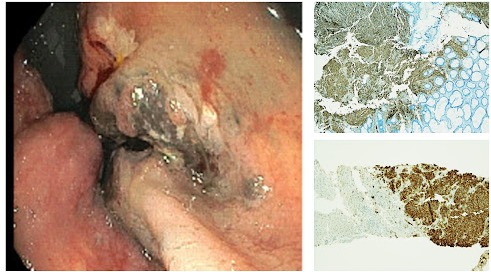Back


Poster Session B - Monday Morning
Category: GI Bleeding
B0338 - Metastatic Anorectal Melanoma as a Rare Cause of Hematochezia: A Case Report
Monday, October 24, 2022
10:00 AM – 12:00 PM ET
Location: Crown Ballroom

Has Audio
.jpg)
Mark Hsu, MD
Kirk Kerkorian School of Medicine at UNLV
Las Vegas, NV
Presenting Author(s)
Mark Hsu, MD1, Kyaw Min Tun, DO1, George Chen, DO1, Skylar Davidson, 1, Lina Chan, 1, Christy Lee Carpenter Diuguid, 1, Priyanthi Jinadasa, MD2, Jose Aponte-Pieras, MD1, Joseph Fayad, MD2, Bhavana Bhaya, MD2
1Kirk Kerkorian School of Medicine at UNLV, Las Vegas, NV; 2VA Southern Nevada Health Care System, Las Vegas, NV
Introduction: Anorectal melanoma is a rare and aggressive subtype of gastrointestinal cancer, accounting for 0.5% of all colorectal cancers. Misdiagnosis of anorectal melanoma is common, as cases oftentimes present with nonspecific symptoms including hematochezia. As such, timely and accurate diagnosis of anorectal melanoma is difficult due to its rarity and nonspecific presentation. Consequently, prognosis is poor due to frequent metastasis by the time of diagnosis.
Case Description/Methods: A 65-year-old male with a history of basal cell carcinoma of the cheek and tobacco use presented with 10 days of hematochezia associated with dyschezia and change in caliber of stool. The patient was noted to have a 10-pound weight loss since a positive fecal immunochemical test 5 months prior. Notably, while he had not had a colonoscopy, his records revealed a prior sigmoidoscopy for similar complaints 4 years prior. Sigmoidoscopy was negative for polyps or tumors but diagnostic of segmental colitis associated with diverticulosis (SCAD); symptoms resolved after a course of oral mesalamine and antibiotics. Family history was positive for a brother with esophageal cancer. Labs were unremarkable for anemia or liver panel abnormalities. Computed tomography imaging of the abdomen showed sigmoid wall thickening, pelvic lymphadenopathy, and multiple liver lesions. Colonoscopy revealed a 0.8x0.5x0.1cm anal mass with biopsies consistent with malignant melanoma; stains were positive for HMB45 and negative for p40 and p63. An ultrasound-guided liver biopsy showed metastatic melanoma positive for HMB45.
Discussion: Hematochezia can arise from anatomical, vascular, inflammatory, and neoplastic etiologies. Although neoplastic causes are the least common, anorectal melanoma represents an especially rare and dismal diagnosis from this category. Risk factors for anorectal melanoma are unknown, although HIV has been previously suggested. HIV screening in our patient was negative. An association between anorectal melanoma and SCAD is unclear. Management of anorectal melanoma is poorly described given the scarcity of the disease but typically consists of surgical resection, although the method and extent of resection is debated. Additionally, the benefit of adjuvant chemotherapy or radiation is unclear. Prognosis of anorectal melanoma is poor, with 5-year survival rates estimated to be no more than 20-30%.

Disclosures:
Mark Hsu, MD1, Kyaw Min Tun, DO1, George Chen, DO1, Skylar Davidson, 1, Lina Chan, 1, Christy Lee Carpenter Diuguid, 1, Priyanthi Jinadasa, MD2, Jose Aponte-Pieras, MD1, Joseph Fayad, MD2, Bhavana Bhaya, MD2. B0338 - Metastatic Anorectal Melanoma as a Rare Cause of Hematochezia: A Case Report, ACG 2022 Annual Scientific Meeting Abstracts. Charlotte, NC: American College of Gastroenterology.
1Kirk Kerkorian School of Medicine at UNLV, Las Vegas, NV; 2VA Southern Nevada Health Care System, Las Vegas, NV
Introduction: Anorectal melanoma is a rare and aggressive subtype of gastrointestinal cancer, accounting for 0.5% of all colorectal cancers. Misdiagnosis of anorectal melanoma is common, as cases oftentimes present with nonspecific symptoms including hematochezia. As such, timely and accurate diagnosis of anorectal melanoma is difficult due to its rarity and nonspecific presentation. Consequently, prognosis is poor due to frequent metastasis by the time of diagnosis.
Case Description/Methods: A 65-year-old male with a history of basal cell carcinoma of the cheek and tobacco use presented with 10 days of hematochezia associated with dyschezia and change in caliber of stool. The patient was noted to have a 10-pound weight loss since a positive fecal immunochemical test 5 months prior. Notably, while he had not had a colonoscopy, his records revealed a prior sigmoidoscopy for similar complaints 4 years prior. Sigmoidoscopy was negative for polyps or tumors but diagnostic of segmental colitis associated with diverticulosis (SCAD); symptoms resolved after a course of oral mesalamine and antibiotics. Family history was positive for a brother with esophageal cancer. Labs were unremarkable for anemia or liver panel abnormalities. Computed tomography imaging of the abdomen showed sigmoid wall thickening, pelvic lymphadenopathy, and multiple liver lesions. Colonoscopy revealed a 0.8x0.5x0.1cm anal mass with biopsies consistent with malignant melanoma; stains were positive for HMB45 and negative for p40 and p63. An ultrasound-guided liver biopsy showed metastatic melanoma positive for HMB45.
Discussion: Hematochezia can arise from anatomical, vascular, inflammatory, and neoplastic etiologies. Although neoplastic causes are the least common, anorectal melanoma represents an especially rare and dismal diagnosis from this category. Risk factors for anorectal melanoma are unknown, although HIV has been previously suggested. HIV screening in our patient was negative. An association between anorectal melanoma and SCAD is unclear. Management of anorectal melanoma is poorly described given the scarcity of the disease but typically consists of surgical resection, although the method and extent of resection is debated. Additionally, the benefit of adjuvant chemotherapy or radiation is unclear. Prognosis of anorectal melanoma is poor, with 5-year survival rates estimated to be no more than 20-30%.

Figure: Figure: (Left): A 0.8x0.5x0.1cm anal mass was detected on colonoscopy.
(Top, Right): Biopsy of the anal mass was positive for immunostain HMB45.
(Bottom, Right): Biopsy of the liver mass was positive for immunostain HMB45, suggestive of metastatic anorectal melanoma.
(Top, Right): Biopsy of the anal mass was positive for immunostain HMB45.
(Bottom, Right): Biopsy of the liver mass was positive for immunostain HMB45, suggestive of metastatic anorectal melanoma.
Disclosures:
Mark Hsu indicated no relevant financial relationships.
Kyaw Min Tun indicated no relevant financial relationships.
George Chen indicated no relevant financial relationships.
Skylar Davidson indicated no relevant financial relationships.
Lina Chan indicated no relevant financial relationships.
Christy Lee Carpenter Diuguid indicated no relevant financial relationships.
Priyanthi Jinadasa indicated no relevant financial relationships.
Jose Aponte-Pieras indicated no relevant financial relationships.
Joseph Fayad indicated no relevant financial relationships.
Bhavana Bhaya indicated no relevant financial relationships.
Mark Hsu, MD1, Kyaw Min Tun, DO1, George Chen, DO1, Skylar Davidson, 1, Lina Chan, 1, Christy Lee Carpenter Diuguid, 1, Priyanthi Jinadasa, MD2, Jose Aponte-Pieras, MD1, Joseph Fayad, MD2, Bhavana Bhaya, MD2. B0338 - Metastatic Anorectal Melanoma as a Rare Cause of Hematochezia: A Case Report, ACG 2022 Annual Scientific Meeting Abstracts. Charlotte, NC: American College of Gastroenterology.
